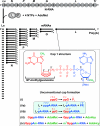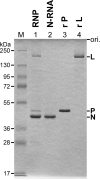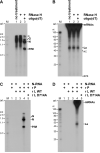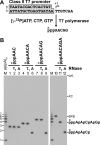In vitro capping and transcription of rhabdoviruses
- PMID: 22687619
- PMCID: PMC3449051
- DOI: 10.1016/j.ymeth.2012.05.013
In vitro capping and transcription of rhabdoviruses
Abstract
The RNA-dependent RNA polymerase L protein of vesicular stomatitis virus (VSV), a prototypic nonsegmented negative strand (NNS) RNA virus classified into the Rhabdoviridae family, has been used to investigate the fundamental molecular mechanisms of NNS RNA viral mRNA synthesis and processing. In vitro studies on mRNA cap formation with the VSV L protein eventually led to the discovery of the unconventional mRNA capping pathway catalyzed by the guanosine 5'-triphosphatase and RNA:GDP polyribonucleotidyltransferase (PRNTase) activities. The PRNTase activity is a novel enzymatic activity, which transfers 5'-monophosphorylated (p-) RNA from 5'-triphosphorylated (ppp-) RNA to GDP to form 5'-capped RNA (GpppRNA) in a viral mRNA-start sequence-dependent manner. This unconventional capping (pRNA transfer) reaction with PRNTase can be experimentally distinguished from the conventional capping (GMP transfer) reaction with eukaryotic GTP:RNA guanylyltransferase (GTase) on the basis of the following differences in their substrate specificity for the cap formation: PRNTase uses GDP and pppRNA, but not ppRNA, whereas GTase employs GTP, but not GDP, and ppRNA. The pRNA transfer reaction with PRNTase proceeds through a covalent enzyme-pRNA intermediate with a phosphoamide bond. Hence, to prove the PRNTase activity, it is necessary to demonstrate the following consecutive steps separately: (1) the enzyme forms a covalent enzyme-pRNA intermediate, and (2) the intermediate transfers pRNA to GDP. This article describes the methods for in vitro transcription and capping with the recombinant VSV L protein, which permit detailed characterization of its enzymatic reactions and mapping of active sites of its enzymatic domains. It is expected that these systems are adaptable to rhabdoviruses and, by extension, other NNS RNA viruses belonging to different families.
Copyright © 2012 Elsevier Inc. All rights reserved.
Figures









Similar articles
-
5'-Phospho-RNA Acceptor Specificity of GDP Polyribonucleotidyltransferase of Vesicular Stomatitis Virus in mRNA Capping.J Virol. 2017 Feb 28;91(6):e02322-16. doi: 10.1128/JVI.02322-16. Print 2017 Mar 15. J Virol. 2017. PMID: 28053102 Free PMC article.
-
Signature motifs of GDP polyribonucleotidyltransferase, a non-segmented negative strand RNA viral mRNA capping enzyme, domain in the L protein are required for covalent enzyme-pRNA intermediate formation.Nucleic Acids Res. 2016 Jan 8;44(1):330-41. doi: 10.1093/nar/gkv1286. Epub 2015 Nov 23. Nucleic Acids Res. 2016. PMID: 26602696 Free PMC article.
-
Histidine-mediated RNA transfer to GDP for unique mRNA capping by vesicular stomatitis virus RNA polymerase.Proc Natl Acad Sci U S A. 2010 Feb 23;107(8):3463-8. doi: 10.1073/pnas.0913083107. Epub 2010 Feb 8. Proc Natl Acad Sci U S A. 2010. PMID: 20142503 Free PMC article.
-
RNA Synthesis and Capping by Non-segmented Negative Strand RNA Viral Polymerases: Lessons From a Prototypic Virus.Front Microbiol. 2019 Jul 10;10:1490. doi: 10.3389/fmicb.2019.01490. eCollection 2019. Front Microbiol. 2019. PMID: 31354644 Free PMC article. Review.
-
Transcriptional Control and mRNA Capping by the GDP Polyribonucleotidyltransferase Domain of the Rabies Virus Large Protein.Viruses. 2019 Jun 1;11(6):504. doi: 10.3390/v11060504. Viruses. 2019. PMID: 31159413 Free PMC article. Review.
Cited by
-
A novel fungal negative-stranded RNA virus related to mymonaviruses in Auricularia heimuer.Arch Virol. 2022 Nov;167(11):2223-2227. doi: 10.1007/s00705-022-05540-5. Epub 2022 Aug 13. Arch Virol. 2022. PMID: 35962823
-
GDP polyribonucleotidyltransferase domain of vesicular stomatitis virus polymerase regulates leader-promoter escape and polyadenylation-coupled termination during stop-start transcription.PLoS Pathog. 2022 Feb 2;18(2):e1010287. doi: 10.1371/journal.ppat.1010287. eCollection 2022 Feb. PLoS Pathog. 2022. PMID: 35108335 Free PMC article.
-
Vesiculopolins, a New Class of Anti-Vesiculoviral Compounds, Inhibit Transcription Initiation of Vesiculoviruses.Viruses. 2019 Sep 14;11(9):856. doi: 10.3390/v11090856. Viruses. 2019. PMID: 31540123 Free PMC article.
-
The large protein 'L' of Peste-des-petits-ruminants virus exhibits RNA triphosphatase activity, the first enzyme in mRNA capping pathway.Virus Genes. 2019 Feb;55(1):68-75. doi: 10.1007/s11262-018-1617-5. Epub 2018 Dec 3. Virus Genes. 2019. PMID: 30511208 Free PMC article.
-
Discontinuous L-binding motifs in the transactivation domain of the vesicular stomatitis virus P protein are required for terminal de novo transcription initiation by the L protein.J Virol. 2023 Aug 31;97(8):e0024623. doi: 10.1128/jvi.00246-23. Epub 2023 Aug 14. J Virol. 2023. PMID: 37578231 Free PMC article.
References
-
- Lyles DS, Rupprecht CE. In: Fields Virology Lippincott. Knipe DM, Howley PM, editors. Williams & Wilkins; Philadelphia: 2007. pp. 1363–1408.
-
- Poch O, Blumberg BM, Bougueleret L, Tordo N. J. Gen. Virol. 1990;71:1153–1162. - PubMed
-
- Volchkov VE, Volchkova VA, Chepurnov AA, Blinov VM, Dolnik O, Netesov SV, Feldmann H. J. Gen. Virol. 1999;80:355–362. - PubMed
Publication types
MeSH terms
Substances
Grants and funding
LinkOut - more resources
Full Text Sources
Other Literature Sources
Miscellaneous

